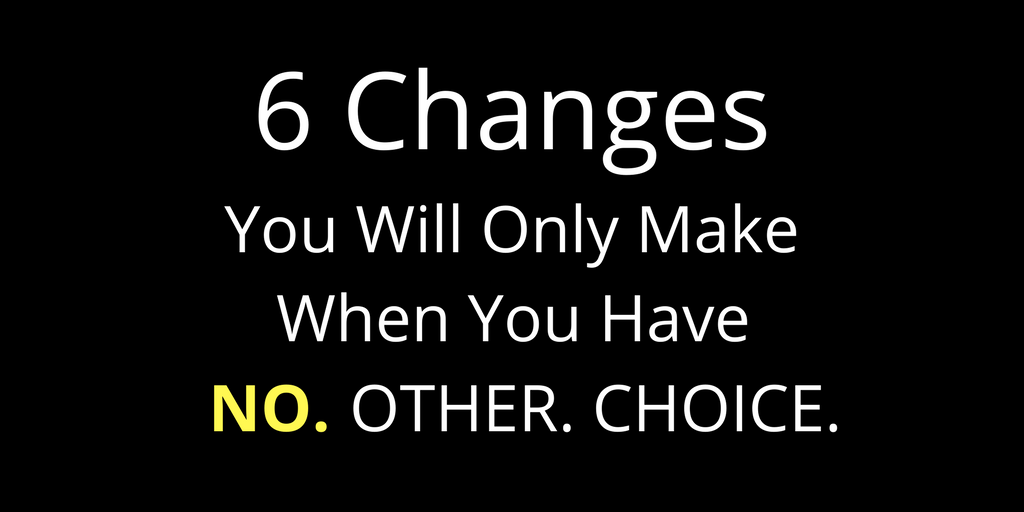6 Changes You Will Only Make When You Have No Other Choice
 “Change happens when the pain of staying the same is greater than the pain of change." —
“Change happens when the pain of staying the same is greater than the pain of change." —
You're aware of this, right? You'd like to lose weight, get healthy, get married, stop drinking, or get out of debt, but changes like that almost never happen until the pain of staying the same is greater than the pain of change.
Well, as much as this is true for our personal lives, it's also true for our small group ministries. There are some changes that we will only make when the pain of staying the same is greater than the pain of change.
I like to say there are changes we will only make when we have no other choice.
6 Changes You Will Make Only When You Have No Other Choice
1. Update your leadership identification process.
You may have inherited the process. You may have had a role in creating it. But, your leadership identification process is almost always a challenge to address and change.
Leadership identification refers to the process that must be completed that determines whether someone can be a leader (i.e., becoming a member of your church, attending the prerequisite leader training class, completing the new leader questionnaire/application, etc.).
Why is the leadership identification process often at the root of a ministry obstacle that needs to be changed? When small group pastors complain that they can't find enough leaders, what they almost always mean is they can't find enough leaders who meet their prerequisite conditions (i.e., becoming a member of your church, attending the prerequisite leader training class, completing the new leader questionnaire/application, etc.).
If you need to find more leaders, you probably need to change your process.
What are the signs you must update your leader identification process?
- Your current leader identification process excludes outsiders.
- Your current leader identification process makes leadership possible for people with the wrong motives.
- You find it easier to add new members to existing groups than to find leaders for new groups.
- Your apprenticing strategy isn't leading to group multiplication fast enough to absorb the unconnected people in your congregation and crowd.
- Unconnected people in your congregation and crowd outnumber connected people.
Are you ready to admit your current method of leader identification leaves a lot to be desired? You're probably not going to get better without a change.
See also, Problem Solved: I Can’t Find Enough Leaders
2. Redesign your leadership development process.
Like your leadership identification process, your leadership development process can be a challenge to address. After all, in most systems once a leader is identified and begins to lead a group any further development is optional and participation is at their discretion.
What are the signs you need to redesign your leader develop process?
- Infrequent or irregular leader training/development experiences.
- Very low percentage of leaders participating in leader training/development experiences.
- The format of your leader training/development experiences is limited to a lecture style meeting.
Are you ready to admit that your leadership development process needs to change? Probably not going to get better without a change.
3. Eliminate excess menu options
Offering a wide menu of belonging and becoming options (i.e., on-campus Sunday School, off-campus small groups, Precepts, Discipleship training, Marriage 101, etc.) and positioning them as alternative ways to get connected or grow in maturity always leads to indecision.
Positioning joining a small group as one of several (or many) next step options leads to fewer people taking a next step. Note: Too many options leads to fewer next steps (i.e., fewer people taking ANY next step, not just joining a small group).
What are the signs you need to eliminate excess menu options?
- Your website feels like a buffet.
- Instead of a single clear next step, there are many options.
- Instead of joining a small group being presented as the best next step, it is presented as one of several ways you can get connected.
Replacing a build-your-own-experience model with end-in-mind pathway leads to more belonging and becoming. Share on X
Ready to admit that you need to eliminate excess menu options? Probably not going to get better results until you streamline menu options.
See also, Small Group Ministry Roadblock #2: A Bloated Belong and Become Menu
4. Design and deploy effective first steps and next steps
The absence of a clearly marked first step out of the auditorium along with an ineffectively designed engagement pathway (or the absence of an engagement pathway) always leads to fewer steps being taken.
While this is not just a small group ministry issue, it is an effective ministry issue and it might be the single biggest issue facing your church.
Ineffective first steps and next steps might be the single biggest issue facing your church. Share on X
As you can see, this change usually happens in combination with eliminating excess menu options.
What are the signs you need to design and deploy effective first steps and next steps?
- You only mention the first step when it is scheduled.
- You don't hold the first step frequently enough.
- New attendees don't know what the first step is.
- Your first step is hidden among the clutter of too many options.
- Your first step presents too many options as the right next step.
Ready to design and deploy effective first steps and next steps? Things probably won't get better until you do.
See also, How to Design Next Steps and First Steps
5. Censor all extraneous marketing
Promotion noise and marketing clutter are root obstacles in building a thriving small group ministry. When unconnected people can't pick out what is most important amidst the noise and clutter of too many other options, they are unlikely to take the step you want them to take.
If you want to highlight the right thing(s) you need to eliminate promotion of the wrong things. You need to narrow the focus to only promote the right things.
What are the signs you need to censor extraneous marketing?
- Announcements during services run on from one very important event to another and another.
- Your worship service bulletin/program feels like a catalog.
- Your website is cluttered with "great" options.
Ready to censor all extraneous marketing? Probably won't get better until you do.
See also, What If Narrowing Your Focus Is THE Missing Piece?
6. Reallocate budgets to current priorities
Does your general budget reflect current priorities? Or does it still reflect yesterday's priorities? Does your staffing strategy reflect current priorities? Or does your org chart reflect yesterday's initiatives?
For example, if you're promoting joining a small group as one of the three things you want everyone to do (i.e., attend a worship service, be in a group, serve in a ministry), but your budget, promotion, room reservations, etc. reflect the day when other objectives were important (i.e., adult Sunday School, men's ministry, women's ministry, etc.)...then it is time to reallocate your budget.
Signs it is time to reallocate your budget:
- Small group ministry is one of several hats you wear.
- You have full or part time staff supporting legacy ministries that are no longer part of your strategy.
- On campus space is allocated irrespective of importance.
- Key small group initiatives are underfunded (while legacy programs funding continues).
Ready to reallocate your budget? Probably not going to see much change until you do.
See also, FAQ: How to Budget for a Thriving Small Group Ministry
Remember, “Change happens when the pain of staying the same is greater than the pain of change."
Need help making these changes? My newest mini-course might be just what you need. How to Design NEXT Steps and FIRST Steps will help you and your team work through the design challenge and reimagine the way things should be. Find out more right here.


